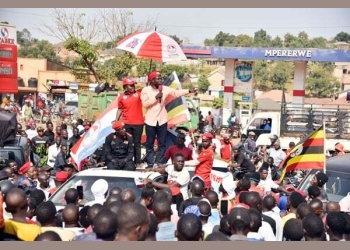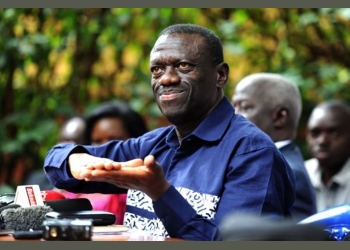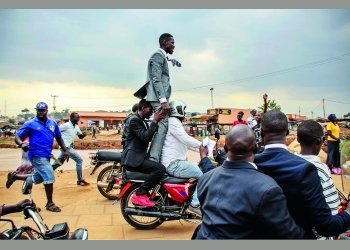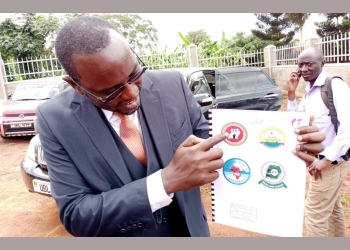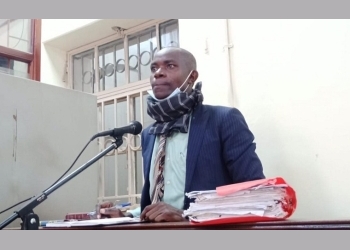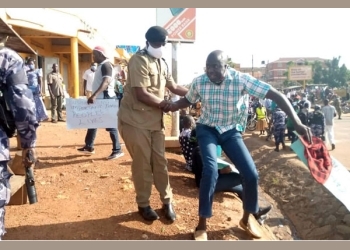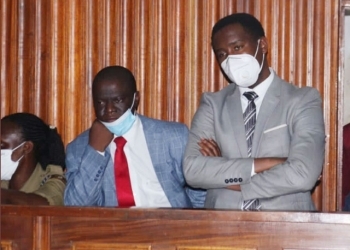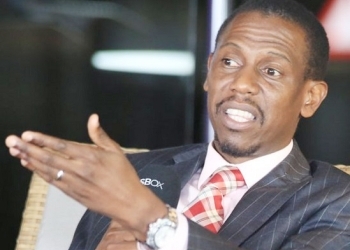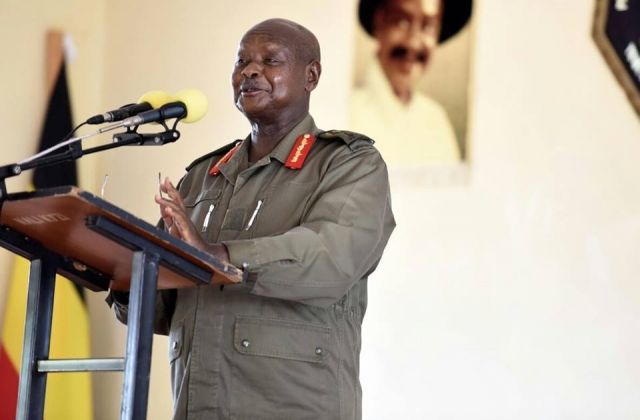
KEYNOTE ADDRESS TO THE JOINT POLITICAL LEADERSHIP: THE NRM CENTRAL EXECUTIVE COMMITTEE, CABINET AND PERMANENT SECRETARIES
REFOCUSING ON THE NRM’S IDEOLOGICAL ORIENTATION
As we have repeatedly pointed out in all the NRM documents, the NRM principles are four: patriotism (anti-sectarianism and anti-gender-chauvinism); pan-Africanism; socio-economic transformation; and democracy.
As the leader of the NRM and its precursors (Fronasa, etc), for almost fifty years today, I must salute the Ugandans in general and our supporters in particular because they have always rallied around our cause. They listened to our message when we were students. They supported us in the anti-Amin struggle ─ witness the Fronasa force we built up so quickly on the western axis in 1978/79. In their millions, they supported us in the anti-UPC war of 1981-86. Ever since 1986, the Ugandans, in their millions, have supported our anti-terrorism military campaigns and our political struggles against opportunism. The Ugandans always support Uganda’s unity against sectarian opportunism ─ (tribal or religious). They always support our stand on Pan-Africanist positions: our support for the SPLM/SPLA struggle in South Sudan, our support for the RPF in Rwanda, our support for the anti-Mobutu struggle, our support for the ANC struggle in South Africa, our efforts in Somalia, our efforts in CAR (Central African Republic), our efforts in Liberia, etc. etc. The people of Uganda always support our stand on the EAC, the East African Federation inclusive. As soon as the East African Anthem was composed, Uganda, without my directive to do so, adopted it as one of the anthems on State functions. Uganda always welcomes the refugees from the African countries. As I speak today, there are: 207,921 refugees from Congo, 257,171 refugees from South Sudan, 36,758 refugees from Somalia, 2,772 refugees from North Sudan, 39,608 refugees from Burundi, 17,367 refugees from Rwanda, etc., etc. Accepting African refugees is part of the solidarity with our African brothers and sisters. However, it is also a component of our Pan-Africanist strategy to work for the unity of Africa in order to ensure our prosperity and the prosperity of our African brothers and sisters. In other documents, we have informed Ugandans about unity, within Uganda and between Uganda and other African countries, being a medicine against poverty and under-development and for prosperity.

Our trade with our African brothers and sisters under EAC and COMESA today brings in US$ 2 billion. Our trade with EU, on the other hand, only brings in US$433 million per year; with China, US$54.7millions per year; with India, US$24.8million per year; with the USA, US$27.2 millions per year; etc. Yet we import so much from China, India, EU, UAE, etc. As I told you in the strategic guidelines, we must export more to the EU, to the USA, to China, to India, to the UAE, to Russia, to Turkey and Central Asia, to Japan and the Far East, etc. It is not correct to support the prosperity of others by massively importing their products (goods and services) while they do not support our prosperity through them importing our goods and services. Our African brothers and sisters, however, are already supporting our prosperity, as already pointed out above, by giving us US$2 billions of goods and services bought from us. This is in spite of the instability and the underdeveloped infrastructure still to be found in the region. How much more will they support our prosperity and we theirs when total peace is restored in this area and infrastructure is developed in the area?
Therefore, Uganda caring for the African refugees that are brought here by adversity, is not just charity. It is also good strategy. Our Banyarwanda comrades stayed here as refugees for 34 years (1960-1994). We gave them all the support we could afford. When they gained ascendance in Rwanda, they opened up that country for interaction, including trade, with East Africa. Today Uganda exports US$263 million worth of goods and services to Rwanda. Rwanda, in turn, is exporting US$78 million worth of goods to Uganda. Through Rwanda Airlines, Uganda is currently contributing about US$ 24.1 million to the prosperity of the people of Rwanda. South Sudan, before the outbreak of the conflict in 2013, was contributing US$ 700 million per annum (exports and remittances) to the prosperity of the people of Uganda. You recently witnessed the exodus of 40,000 plus Ugandans that came back from South Sudan on account of the present conflict there. What were they doing there? Looking for prosperity. Therefore, Ugandans should know that unity within Uganda and Pan-Africanism in the whole of Africa are not mere acts of solidarity but are also investments to create a better framework for the prosperity of all Africans.
I, therefore, salute Ugandans for welcoming our brothers and sisters, the African refugees as well as other African business persons. It is the cumulative, Pan-Africanist efforts of as many Africans as are enlightened on this point that will guarantee the prosperity of the African people.
Even to negotiate credible and durable trade deals with the USA, the EU, China, India, Japan, Russia, Brazil, etc., we need Pan-Africanism. It is only through the EAC (160 million people) and the whole of Africa (1.25 billion people) that the other foreign countries or trading blocs can listen to our voice in the long run.
It is, however, not correct for the regulators not to take action against the Chinese and Indian retailers who unfairly compete against our retailers. Those foreigners should not operate at that terminal level. They should be re-directed to manufacturing in particular and other areas like construction. Retailing should be preserved for the Ugandans or, possibly, the other African immigrants as well.
Therefore, the Ugandans have internalized, generally speaking, three of the four principles of the NRM: patriotism, Pan-Africanism and democracy. Although there are still opportunists who try to revive sectarianism, they are ever diminishing in importance. It is principle number three, socio-economic transformation, that is still problematic. It is the one we need to focus on vigorously. What, again, is socio-economic transformation? It is the evolution of society from lower forms of social organizations to higher forms. The universes (the earth, the sun, the stars and the galaxies) have been in existence for about 14 billion years. It is believed that the galaxies came from an explosion of dense nucleus of elementary particles of gas, a process known as the big bang. Atoms were later formed as the gas expanded and cooled. Our galaxy, the Milky Way, is comprised of billions of suns/stars including our sun, as well as planets: such as Mercury, Venus, Earth, Mars, Jupiter, Saturn, Uranus, Neptune, etc, rotating around the galactic center. There are other galaxies such as Andromeda, Magellan, Black eye, Cigar, Comet and many more. The word ‘galaxy’ is derived from the Greek word for ‘milk’ and is the reason that the band of light and stars across the sky is called ‘the Milky Way’.
It is thought that our own planet, earth, solidified about 4.5 billion years ago. Unicellular creatures started emerging about 3.8 to 4 billion years ago. Multi-cellular creatures started emerging about 700 or 800 years ago. About four million years ago, the human beings started evolving from apes. This was following the last glacial period ─ the ice-age. The first human-like creatures evolved in East Africa. Why? It was because it was open grass land. In the grass land, walking on four legs (Quadra-pedal) obstructed vision and could not allow somebody to see far. That is how gradually, some of the apes became bipedal (two-legged). Bipedalism is one factor that distinguishes man from other mammals. The other two are a hand that grips things and shapes tools and a large brain. The average human brain for men is 1273.6cc and 1131.1cc for women. It has been growing from 400cc, 4 million years ago to the present size of 1350cc. Since 3100 BC, these human groups started living in civilized societies. The early civilizations were in Egypt, Mesopotamia, Babylon, etc, around the years 3000BC and 3500BC respectively. In all those millennia, the primer for social change is the advancement of science and technology. The earliest example of technological revolution was the invention of fire around 350,000 years BC.
With the invention of fire, the human beings could now move from being tree-dwellers and become cave dwellers because they could light the inside of caves and warm the caves. Karl Marx pointed out that the human society had gone through five social systems: primitive communalism, the slave state, feudalism, capitalism and socialism.

Initially, society was classless ─ all people were equal ─ hunters or gatherers. As time went on, differences in society emerged. As you saw above, slave owners and slaves emerged. Later on, the societies evolved into serfs and feudal land-lords. After the middle-ages in Europe, the feudal society metamorphosed into a capitalist society, culminating in the French Revolution of 1789. The French society of 1789 is always a very good example of social evolution up to that time, reflecting what was going on, at different paces, in other European societies. By that time, France was a four-class society:
1. The feudalists (the Aristocrats);
2. The middle-class (the bourgeoisie);
3. The working class (the Proletariat); and
4. The peasants.
Each of these social classes was maintained in different ways. The feudalists sustained themselves by taking rent on land (busuulu and nvujjo) from the peasants. The bourgeoisie sustained themselves by taking the difference between the cost price and the selling price of a good or a service which is called profit. This concept of profit was revolutionary because the previous societies were not very clear on this point.
Even today, you can find some African societies that engage in activities that are not costed. They cannot, therefore, know whether what they are doing is profitable or not. How much did the concept of profit help in the process of wealth-creation and wealth expansion? All modern thinkers should reflect on this. Islamic Banking is, for instance, apparently, against the concept of profit (riba). They call it haram (abominable ─ unholy or whatever). Is this revulsion against profit correct? Our think-tanks should reflect over these issues; we should not just go on without a historical compass. The Banyankore had both a credit policy and an insurance policy. Credit had two elements: Omukwaaato and Obunaku. Banyankore regarded with revulsion the idea of selling female cattle. They only sold or slaughtered either bulls or infertile cattle (enguumba or emberera). If, therefore, one had an urgent need of cattle for slaughter or sale and lacked one himself, he could approach another person with one of the two offers. Either he would offer omukwaato or obunaku. With omukwaato, you would give the lender a female producing cow in exchange for an appropriate slaughter or sale one. The omukwaato cow would stay with the lender until it produced and weaned a female calf (echukire). Then the omukwaato cow would redeem itself (okwechungura). If it produced bull calves in the meantime, they would, on weaning, belong to the borrower. The lender would, however, take the milk for all the time until the termination of the deal. With the obunaku, the borrower would take a slaughter or sale cow (enguumba, etc) or bull (endaaho) from the lender. After a stipulated time, say three years, the borrower would give a female cow (a weaner or a mature cow) to the lender.
The solution for social insurance was to run to the aid of somebody that had experienced calamity on account of the death of one’s cattle. This was called okushumbuusha. Your friends would kushumbuusha you. After some years, you would pay back to each of them a female weaner and the debt would be over. There was also empaano. This was like entandikwa (initial capital) for the poor beneficiary vis-avis a richer person or it could simply be an exchange of gifts among rich equals. As you can see, all these were the “Islamic Banking” of the Banyankore. They were all the pre-capitalist forms of credit among the Banyankore.
I have spent abit of time on the issue of profit as I reminded the audience of the phenomenon of the middle-class (the bourgeoisie) in the evolution of the society. This is because I consider it crucial to understand the instruments the different societies used to generate and expand wealth (Obugaiga, Lonyo-Luo, Abar-Ateso, Lonyi-Lugbara).
The fourth social class during the time of the French Revolution were the peasants as already pointed out above. These depended on their sweat minus what the land-lord took as rent (busuulu and nvujjo).

As capitalism developed, between 1400AD and 1800AD, another ideology also came up. This was the ideology of socialism. This was the ideology of the working class distilled by the intellectual Karl Marx, Engels, etc and, later, Lenin, Mao Tse Tung and others. On account of the concentration of wealth in Europe in fewer and fewer hands, the vast majority of the people came to the point of where they owned nothing ─ no land, no property of any type (house, hotel) and no business (shipping, banking, transport, etc). As Hunt R. Margaret put it in the Oxford Handbook of Modern European History, 1350-1750 Vol.1 on page 344 when she interpreted Karl Marx’s opinion on the Communist Manifesto of 1848, “they owned nothing except their labour”. The exact quotation goes as follows:
“In the early modern and modern periods, according to Karl Marx, the ‘bourgeois’ or ‘capitalist’ class owned the means of production (capital to invest, raw materials, the factories, the machines) while ‘working class’ people owned nothing except their own labour which they found themselves having to sell for a pittance to capitalists.”
The communists, therefore, believed that the State (the Government), acting on behalf of all the people should take the “commanding heights” of the economy (land, banking, etc), otherwise capitalism, since it ever concentrated wealth into fewer and fewer hands, would come into crisis and would stop being rational (as it was at the beginning of its onset) and become, not only irrational, but also, a fetter on the greater productivity of society.
In 1917, exactly 128 years after the French Capitalist Revolution, a Socialist Revolution took place in Tsarist Russia. Rapidly, the Soviet Union emerged as a very powerful State until it got into crisis in 1990. In 1949, the Soviet Union was joined by the People’s Republic of China as another communist country.
We the African revolutionaries, have been studying all these phenomena and we have avoided the bigotry of some circles and pointed out to all and sundry that both capitalism and socialism are modern systems. They can help to advance society to higher levels of production of wealth and affluence. Capitalism uses the selfishness of people, driven by the profit motive, to aggressively and efficiently create and expand wealth. Since, however, capitalism concentrates on private profitability in a single enterprise (a factory, a hotel, a business), they can easily forget social profitability (collective gain). A bar owner may get very good profits from selling alcohol. Society as a whole, however, may lose on account of the increased alcoholism in society. Private profitability vs social profitability. You could also describe this as the contradiction between micro-profitability vs macro profitability for the whole economy. We in the NRM, therefore, have never accepted the shallow social science of the Western countries that fetishized capitalism and elevated that useful social system, but one with limitations and weaknesses nevertheless, to the high pedestal of a deity (God-like). The position that capitalism was the only useful social system in the modern era, was wrong. The dramatic rise of the Chinese economy, in terms of GDP size, to the second biggest economy in the world today is proof of the correctness of our position. By mixing both the capitalist and socialist stimuli to the Chinese economy, the Chinese Communist Party has lifted hundreds of millions of Chinese out of poverty and registered gigantic steps for the growth and transformation of the economy. In the NRM’s 10 points programme, point no. 10 was, indeed, emphatically saying that, for us, we believed in the use of the strategy of a mixed economy. Below are the NRM Ten Points Programme:

POINT N0. 1
Restoration of Democracy
POINT N0. 2
Restoration of Security
POINT N0. 3
Consolidation of national unity and elimination of all forms of sectarianism.
POINT N0.4
Defending and consolidating national independence
POINT N0. 5
Building an independent, integrated and self-sustaining national economy
POINT N0.6
Restoration and improvement of social services and rehabilitation of war ravaged areas
POINT N0. 7
Elimination of corruption and the misuse of power
POINT N0. 8
Redressing errors that have resulted in the dislocation of some sections of the population
POINT N0. 9
Cooperation with other African countries
POINT N0. 10
Following an economic strategy of a mixed economy
Therefore, when today we talk of the principle no. 3 of the NRM, the principle of socio-economic transformation, we should know that we are not treading on an un-trodden path. Many societies have already trodden that path. Initially, it was the societies of Western Europe that between 1400AD and 1900AD metamorphosed from feudal societies to middle-class and skilled working class societies. Between 1945 and today, huge sections of the Asian populations in China, India, Malaysia, Indonesia have similarly done so. It is now the single most important task of the NRM.
The 23 points guidelines I gave you recently are in order to achieve this by initially enabling Uganda to become a Middle Income status country by 2020 and a First World country in the next 30 years if not less. We have long started on that journey. By identifying the ten strategic bottlenecks, we had correctly diagnosed the sickness. In order to remind ourselves, the 10 strategic bottlenecks are:
(i) ideological disorientation;
(ii) a weak state, especially the army, that needed restructuring;
(iii) the suppression of the private sector;
(iv) the underdevelopment of the human resource (lack of education and poor health);
(v) the underdevelopment of the infrastructure (the railways, the roads, the electricity, the telephones, piped water, etc);
(vi) a small internal market;
(vii) lack of industrialization;
(viii) the underdevelopment of the services sector (hotels, banking, transport, insurance, etc.);
(ix) the underdevelopment of agriculture; and
(x) the attack on democracy.
By dealing with each of these strategic bottlenecks, we are either directly or indirectly, contributing to the struggle for the socio-economic transformation of our society.

Indeed, all of them impact on this struggle. Education for all and improved health for everybody does. Educated people can more easily move into the middle-class than the uneducated. Emancipating the private sector through liberalization impacts social evolution in two ways: by encouraging entrepreneurs to emerge who, then, become employers and, then, the employers taking on employees. With one stroke, two elements of two social classes are created: the middle-class and the working class. Handling strategic bottleneck no. 9, the under-development of agriculture, will mean dealing with the 68% of the homesteads that are still in subsistence agriculture. By handling infrastructure, we are creating a modern base for the economy that will enable entrepreneurs to produce goods and services cheaply, which means that Uganda will be competitive. If we produce expensive or poor quality goods, nobody will buy them. If people, local and foreign, do not buy our products or use our services, our entrepreneurs will collapse or will not expand. All that will negatively affect jobs , etc. It is a vicious cycle ─ one problem, leading to another.
In conclusion and simply put, socio-economic transformation means discarding negative old traditions, going from manual, non-skilled labour to skilled and intellectual labour.
We must move from feudal relationships and practice middle-class relationships and practices. The peasant class will be phased out. A peasant should not produce another peasant in the NRM era. A peasant should produce a skilled worker, a middle-class entrepreneur, a professional able to market his/her professionalism or an intellectual. In that way, as a consequence of addressing the 10 strategic bottle-necks, our society will undergo socio-economic transformation. Indeed, that socio-economic transformation is already taking place. It is a question of intensifying and expediting the process. Uganda will become a middle-class and skilled working class society based on the four sectors of our economy: a modern commercial agriculture, industries (factories), modern services and ICT.
I thank you.
26th July, 2016 - Kyankwanzi



